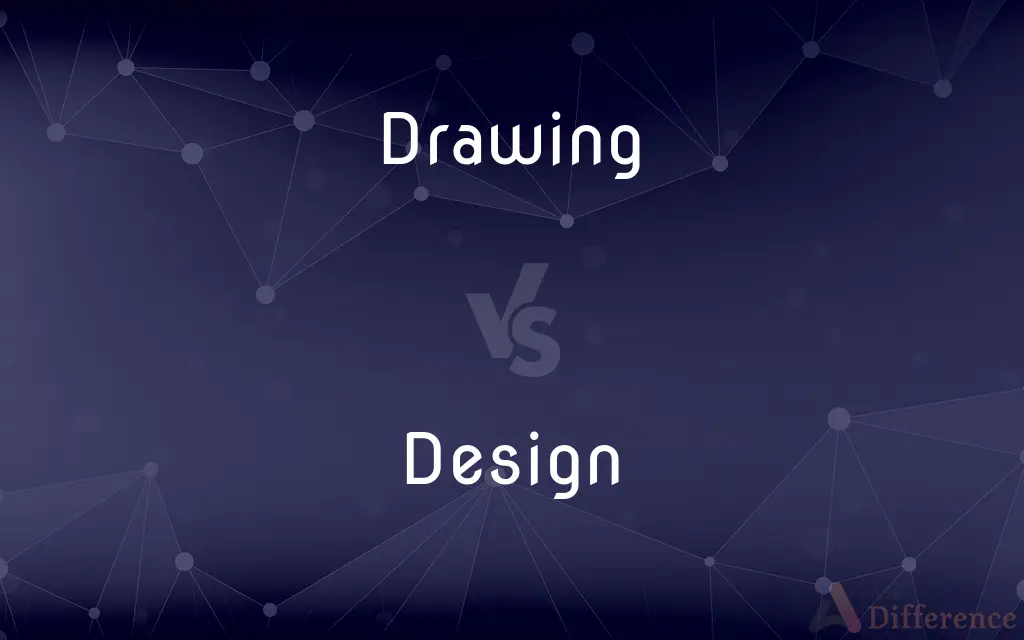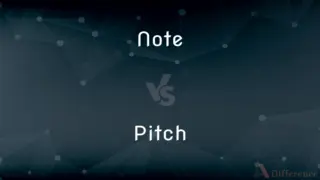Drawing vs. Design — What's the Difference?
By Tayyaba Rehman & Fiza Rafique — Updated on March 1, 2024
Drawing is the art of creating visual marks on a surface to represent objects or ideas, focusing on manual skills and observation. Design involves planning and arranging elements in a way to achieve specific objectives, requiring creativity.

Difference Between Drawing and Design
Table of Contents
ADVERTISEMENT
Key Differences
Drawing primarily uses tools like pencils, pens, and brushes to create imagery on surfaces such as paper or canvas. It's an expressive medium that captures the artist's perspective, emotions, or a visual representation of an object. Design, however, encompasses a broader scope, including digital tools and software to conceive and plan the creation of objects, systems, or interactions with specific functions, aesthetics, or meanings in mind.
Drawing can stand alone as a final piece of art, it often serves as a preliminary step in the design process. Artists draw to explore ideas, shapes, and compositions that might later be refined into designs. Conversely, design projects often start with sketches but move quickly to include considerations of usability, user experience, and materials, which are less emphasized in traditional drawing.
Drawing emphasizes the accurate representation or abstraction of subjects based on the artist's skills and style. It's more about the direct connection between the artist's hand and the medium. Design, in contrast, requires a deliberate selection and arrangement of elements—whether textual, visual, or spatial—to communicate messages or solve problems, often involving a team and multiple revisions.
The skills and techniques in drawing, such as shading, perspective, and composition, are valuable foundations for any designer. These skills enhance the designer's ability to visualize and iterate concepts effectively. However, design additionally demands knowledge of principles such as balance, contrast, and hierarchy, which are crucial for creating compelling and functional outcomes.
Both drawing and design rely on creativity and visual communication but serve different purposes and audiences. Drawing is an end in itself, celebrated for its aesthetic and expressive qualities. Design's value lies in its ability to conceive solutions and experiences that are aesthetically pleasing, functional, and meet specific objectives or needs.
ADVERTISEMENT
Comparison Chart
Definition
The art of making marks on a surface to create images.
The process of planning and creating with specific goals in mind.
Primary Focus
Representation or abstraction of visual subjects.
Solving problems or achieving objectives through visual means.
Tools
Pencils, pens, brushes, paper, etc.
Digital software, sketches, models, etc.
Skills
Manual dexterity, observation, artistic expression.
Creativity, problem-solving, technical and conceptual planning.
Outcome
Artistic works intended for visual appreciation.
Functional products, systems, or services designed with a purpose.
Compare with Definitions
Drawing
Ink illustrations in a book.
The drawings added a whimsical touch to the children's story.
Design
The layout of a website.
The website's design improved navigation and user experience.
Drawing
A pencil sketch of a landscape.
The artist's drawing captured the serene beauty of the countryside.
Design
A logo for a brand.
The design of the new logo aimed to reflect the company's innovative spirit.
Drawing
Digital art on a tablet.
His drawing on the digital platform was incredibly lifelike.
Design
An ergonomic chair.
The chair's design focused on enhancing comfort and support.
Drawing
Architectural blueprints.
The architect's detailed drawing outlined the new building's design.
Design
Urban planning of a new district.
The urban design aimed at creating a sustainable and livable community.
Drawing
A charcoal portrait.
Her drawing of the model emphasized the intense gaze.
Design
A fashion collection.
Her design collection showcased at the fashion week was inspired by vintage styles.
Drawing
Drawing is a form of visual art in which an artist uses instruments to mark paper or other two-dimensional surface. Drawing instruments include graphite pencils, pen and ink, various kinds of paints, inked brushes, colored pencils, crayons, charcoal, chalk, pastels, erasers, markers, styluses, and metals (such as silverpoint).
Design
A design is a plan or specification for the construction of an object or system or for the implementation of an activity or process, or the result of that plan or specification in the form of a prototype, product or process. The verb to design expresses the process of developing a design.
Drawing
The act or an instance of drawing.
Design
A plan or drawing produced to show the look and function or workings of a building, garment, or other object before it is made
He has just unveiled his design for the new museum
Drawing
The art of representing objects or forms on a surface chiefly by means of lines.
Design
A decorative pattern
Pottery with a lovely blue and white design
Drawing
A work produced by this art.
Design
Purpose or planning that exists behind an action, fact, or object
The appearance of design in the universe
Drawing
A representation of forms or objects on a surface by means of lines;
Drawings of abstract forms
He did complicated pen-and-ink drawings like medieval miniatures
Design
Decide upon the look and functioning of (a building, garment, or other object), by making a detailed drawing of it
A number of architectural students were designing a factory
Drawing
Act of getting or draining something such as electricity or a liquid from a source;
The drawing of water from the well
Design
Design something for a specific role or purpose or effect;
This room is not designed for work
Drawing
The act of moving a load by drawing or pulling
Design
Create the design for; create or execute in an artistic or highly skilled manner;
Chanel designed the famous suit
Design
Make a design of; plan out in systematic, often graphic form;
Design a better mousetrap
Plan the new wing of the museum
Design
Create designs;
Dupont designs for the house of Chanel
Design
Intend or have as a purpose;
She designed to go far in the world of business
Common Curiosities
Which is more important, drawing or design?
Neither is more important; they serve different purposes and can complement each other in creative fields.
What is the main difference between drawing and design?
Drawing focuses on creating visual art through marks on a surface, while design involves planning and creating with specific objectives in mind.
Can a design be considered art?
Yes, designs that emphasize aesthetic and innovative qualities can be considered art.
Is design always digital?
No, design can be both digital and non-digital, involving physical models, sketches, or prototypes.
How do drawing and design contribute to society?
They contribute by enhancing cultural, functional, and aesthetic aspects of the environment and products.
Is drawing only about realism?
No, drawing encompasses a wide range of styles, from realistic to abstract representations.
Can drawing be part of the design process?
Yes, drawing can be a preliminary step in designing, used to explore ideas and concepts.
Do designers need to know how to draw?
While not always necessary, drawing skills can greatly benefit designers by enhancing their ability to visualize and iterate concepts.
What roles do creativity play in drawing and design?
Creativity is central to both, driving innovation in design and expression in drawing.
Can drawing enhance design skills?
Yes, drawing can improve visual literacy and conceptual thinking, beneficial for design.
Is the approach to drawing and design the same?
The approach differs; drawing is more about expression and observation, while design focuses on solving problems and meeting objectives.
Can anyone learn to draw or design?
Yes, with practice and study, anyone can develop skills in drawing and design.
Are drawing and design mutually exclusive?
No, they often overlap and inform each other in various stages of the creative process.
How do outcomes of drawing and design differ?
Drawing outcomes are typically artistic works, while design outcomes are functional products or systems.
How do tools differ between drawing and design?
Drawing uses traditional tools like pencils and paper, while design often incorporates digital tools and software.
Share Your Discovery

Previous Comparison
Note vs. Pitch
Next Comparison
Bash vs. AshAuthor Spotlight
Written by
Tayyaba RehmanTayyaba Rehman is a distinguished writer, currently serving as a primary contributor to askdifference.com. As a researcher in semantics and etymology, Tayyaba's passion for the complexity of languages and their distinctions has found a perfect home on the platform. Tayyaba delves into the intricacies of language, distinguishing between commonly confused words and phrases, thereby providing clarity for readers worldwide.
Co-written by
Fiza RafiqueFiza Rafique is a skilled content writer at AskDifference.com, where she meticulously refines and enhances written pieces. Drawing from her vast editorial expertise, Fiza ensures clarity, accuracy, and precision in every article. Passionate about language, she continually seeks to elevate the quality of content for readers worldwide.
















































